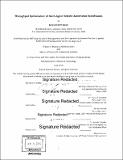Throughput optimization of multi-agent robotic automated warehouses
Author(s)
Stowe, James DeWitt
DownloadFull printable version (15.74Mb)
Other Contributors
Leaders for Global Operations Program.
Advisor
Bruce G. Cameron and Roy Welsch.
Terms of use
Metadata
Show full item recordAbstract
In 2003 Kiva Systems (now Amazon Robotics) introduced a new type material handling automation to the world. The system is based on the principle that the physical infrastructure that contains inventory should be mobile. Kiva achieved this remarkable advancement by employing a fleet of robots to move shelving to human operators. Broadly, these types of systems are defined in the literature as multi-agent robotic systems. Amazon acquired Kiva Systems in 2012 to incorporate the technology into their operations. The goal of this thesis is to optimize the throughput of warehouses employing multi-agent robotic automation. It is assumed that extracting inventory from the automated system is the limiting factor in maximizing throughput (i.e. downstream process are unconstrained). Two strategies are advocated: 1) performing velocity segregation of inventory within the automation via a bifurcation between fast selling and slow selling inventory, 2) maximizing pick rates through policies that increase worker retention. It will be shown that velocity segregation increases machine efficiency by increasing the efficiency of delivering inventory to human operators. This assertion will be investigated by developing a theoretical understanding of how inventory velocity impacts machine efficiency and simulating different types of stow strategies impact on system efficiency. It is estimated that some stow strategies can increase machine efficiency by as much as 30%. It will also be shown that the number of man-hours worked by inexperienced pickers explains practically all of the variability of aggregate pick cycle times and hence pick rates, which motivates the argument for worker retention. Together, these two modifications are estimated to increase throughput by 10% over current baseline.
Description
Thesis: M.B.A., Massachusetts Institute of Technology, Sloan School of Management, 2016. In conjunction with the Leaders for Global Operations Program at MIT. Thesis: S.M. in Engineering Systems, Massachusetts Institute of Technology, School of Engineering, Institute for Data, Systems, and Society, 2016. In conjunction with the Leaders for Global Operations Program at MIT. Cataloged from PDF version of thesis. Includes bibliographical references (pages 105-107).
Date issued
2016Department
Leaders for Global Operations Program at MIT; Massachusetts Institute of Technology. Engineering Systems Division; Massachusetts Institute of Technology. Institute for Data, Systems, and Society; Sloan School of ManagementPublisher
Massachusetts Institute of Technology
Keywords
Sloan School of Management., Institute for Data, Systems, and Society., Engineering Systems Division., Leaders for Global Operations Program.